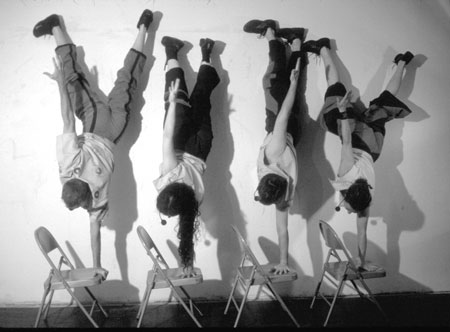By Davida Singer
Members of Chicago’s Plasticene Theater Company in a production of ‘The Palmer Raids’ at the Ohio Theater
Athleticism and politics collide in “The Palmer Raids,” a super charged performance piece by Chicago’s touted Plasticene Theater Company. In their New York debut at the Ohio Theater, Plasticene presents a docudrama recounting the U.S. mail bombings and their chilling aftermath in the early 1920’s.
“The show takes place in a 15-month period of 1919-20, when 34 mail bombs were sent all over the country to influential figures like J.P. Morgan and John D. Rockefeller,” says Plasticene’s artistic director, Dexter Bullard. “The Department of Justice cracked down in what became the first Red Scare, as 250 people were deported and over 5000 arrested with no judicial process. It was a trade-off of liberty for safety – a frightening time in American history. It’s all so shockingly similar to Ashcroft and today’s situation. The play is looking at the past and what it tells us of the present – the demonization of someone else in order to cleanse.”
Fresh from its acclaimed run in Chicago, “The Palmer Raids” carries the unique Plasticene qualities of “gritty, honest, visceral theater” and taking the idea of acting to a high, subtle form of physicality.
“We ask, what could actors do if they challenge the physical side of acting and how objects work,” Bullard explains. “In this show, a table isn’t used as a table, it’s rolling or flying. We do what I call ‘hyper-blocking’, almost choreography – a maddening blend of performance art and dance. Our idea is about transformation of objects, and jumps in time, sometimes very similar to a live cinema. Audiences leave with very different stories about what’s going on. Narrative finality is with the viewer – quite mysterious.”
According to Bullard, company members use specific resources in the process of creating a show-typically an object, casting or space.
“In this case,” the director says, “we utilized an historical event and human voice. This was new for us, as our attention is usually to physicality and the refusal to use language. The question here was, could we tell a story in a way to create political feeling, for once, to open people’s assumptions about how forgetful Americans are of our own past.”
On stage, “The Palmer Raids” set – 4 lamps, 3 rolling tables, 15 folding chairs, 16 boxes, 4 performers, 4 mics, an overhead projector, and a laptop for live music and sound, (processed by Eric Leonardson) – resembles an unloaded moving van.
“We use it all to portray two bombings and four court cases,” explains Bullard. “It starts with the mail bombing of April 29 and ends with the Wall Street bombing in 1920. Through that, we thread individual stories of Emma Goldman, utopian/anarchist, who was actually deported; Asst. Secretary of Labor, Lewis F. Post; Horace Peters, an imaginary everyman character; and Attorney General, A. Mitchel Palmer, who believed the law could be exercised justly. Tables and chairs are tossed around, and we use our high physicality and playfulness as well.”
Is there any special message he’d like to impart?
“First, that we’re truly dedicated, and I’d like New Yorkers to know that Chicago is a city of great theatrical energy. Hopefully, people will see what an amazing complexity can come from simple elements. I’d like them to leave saying, ‘Wow! That was a visceral, shocking, fast moving show-all from a bunch of folding chairs.’ And there’s a political message here too. For a theater company that didn’t speak since we formed in 1995, it took the events of the last two years to mandate that we as artists use our voices. It’s not a time to be quiet.”





































